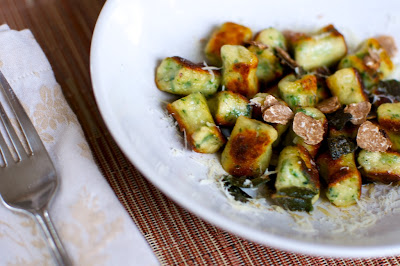The woods were alive with the sounds of trufflers. Dozens of humans and canines barked and yipped and hollered their triumphs and failures through a gloomy grove of 25-year-old Douglas-firs. They ran to and fro, scratching in the dirt with paws and garden cultivators. Most were amateurs, brought together by the 7th annual Oregon Truffle Festival. Longtime truffle researcher Dan Luoma of Oregon State was on hand to offer guidance. Just about everyone found winter white truffles (Tuber oregonense), though the season’s odd weather patterns meant that most of the truffles were still small and less than perfectly ripe.


Later, at a luncheon at Willamette Valley Vineyards, I ate one of the best truffle dishes I’ve ever had: a Pinot Noir-braised pork belly with white truffle-onion jam, dried cherries, and a frisee with raspberry-black truffle vinaigrette (see below). It was a perfectly balanced blend of flavors and textures that was expertly knitted together by the truffle jam. This was proof that an Oregon truffle experience could be a culinary epiphany rather than a shrug.
Eating our home-grown truffles is not always so revelatory. Truffles get raked up too young, sold to retailers who don’t know any better, and then passed on to customers who have no benchmark for comparison.
Fortunately this is not the case with the Oregon Truffle Festival, which aims to educate as well as nourish. The talks and lectures from truffle experts the world over were illuminating, and though not every single dish served over the course of eight different multi-course meals throughout the weekend was a resounding success, most of the dishes used generous amounts of ripe truffles in toothsome ways that showed off the fungi’s singular qualities.
The Oregon Truffle Festival is held at the end of January each year in Eugene, Oregon, in the southern Willamette Valley. The valley is ground zero for our native edible truffles, though they can be found from the Fraser River Valley in British Columbia south to Northern California, in low elevation coastal Douglas-fir forests. This contrasts with European truffles, which are generally found in hardwoods.
During our bus ride to the truffle patch, Luoma, a forest ecologist, explained that the Willamette Valley offers the best climatic conditions for our native truffles (not too hot in summer, not too cold in winter) and that truffles in general seem to prefer habitats near human activity, in particular cleared agricultural fields replanted with orchards. Truffles have long been associated with wine country, and this association is true for the vineyards of Willamette Valley, many of which have nearby Christmas tree farms or planted groves of Douglas-fir for timber or water retention.
In addition to the guided forays and lectures, the festival included dog-training workshops, cooking classes, and a grower’s forum for the brave cultivation set.

Saturday night’s Grand Truffle Dinner, the coup de grace, was as over the top as promised. I arrived, along with 300 other guests, at a hotel ballroom suffused with the aroma of Oregon black truffles (Leucangium carthusianum). Three-hundred plates covered three long prep tables as the first course made its debut, each plate decorated with a square of Celery Root & Black Truffle Panna Cotta topped with Dungeness Crab Salad & Parisian Pears. The kitchen staff, armed with mandolines, roamed up and down the line, shaving away. The scent of black truffles hung in the air like a heavy fog. Indeed, it was nearly disorienting.

My favorite dish of the night was probably the second course, White Truffle Scented Red & White Quinoa in a Creamy Risotto Style with Riesling Poached Hen’s Egg, Shaved Coppa, Wild Winter Herbs, Lemon Thyme Emulsion & Shaved White Truffles. My favorite dessert of the weekend was a chorus of truffled sweets served earlier that day at Willamette Valley Vineyards: White Truffle Panna Cotta, White Truffle Raspberry Mousse, White Truffle Infused Tapioca, and White Truffle Brittle.

If you’re a lover of truffles who can’t afford a trip to Italy (and who can these days?) or simply curious, I highly recommend the Oregon Truffle Festival. Though not exactly inexpensive, the festival delivers plenty of value for the cost, and as far as I could tell there was no scrimping on the truffles. Festival founders Charles Lefevre and Leslie Scott run an action-packed weekend and the attendees are fun people who enjoy a good time. I made a lot of new friends at the festival, which is reason enough to spend a weekend in the beautiful and bounteous Willamette Valley.
Like this:
Like Loading...




































